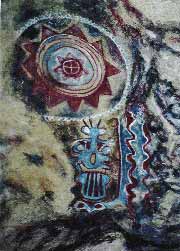




|
 |
 |
 |
When the highlands of Scotland were filled with evergreens so thick and tall you could not pass, the Chumash lived in California on the rolling hills of Santa Barbara. Their villages stretched from San Luis Obispo to near Los Angeles and out into the Central Valley. They were the oldest and most culturally defining society in California. The Chumash lived in a series of small villages along estuaries. The two largest were located in what are now Goleta and Santa Barbara.
The Chumash were among the least nomadic people the world has ever known. Staying through drought and earthquakes, they experienced both famine and the rise of the sea with the last ice age. The longest Chumash legends speak of their people coming to the land we now know as California, in boats directly from the West. A Chumash burial site discovered on San Miguel Island several years ago was found to be 13,000 years old and genetically of Polynesian origin.
 These were extraordinary people that we are only now coming to appreciate and perhaps we could even learn from their examples.
These were extraordinary people that we are only now coming to appreciate and perhaps we could even learn from their examples.
The Chumash lived in peace. They had never used war as an accepted means of theft. The taking of human life was viewed as a tragedy they worked to prevent. They lent their minds to developing customs for the mediation of conflict.
They engaged in peaceful trade and traded to places as far away as the Southwest. Their baskets are among the most beautiful and prized ever made. Such a basket today easily sells for $250,000. In the days of the Chumash, the wealth of an individual went into the grave with them.

Women were freer in Chumash society than in most parts of the world today. A female child grew up knowing she was a full citizen and expecting to be honored for the excellence of her work.
At age twelve a young female would go through the ceremony that enabled her to identify her spirit helper. She would receive the stone figurine that represented this entity, keeping it for the rest of her life.
This spiritual quest prepared her to function in the Chumash society. She would already have been considering what she would do as an adult and no options were closed to her. She studied techniques for making tools and was encouraged to find innovations that improved what was possible.Chumash women lived in a world that enabled and empowered their dreams. They lived lives filled with work and learning and relationships.
The family structure was different than what is common in America today, if she was an older sibling, her younger sibling would probably address her as Elder-sister, a title of honor. She would help raise the younger child, freeing her mother for other work and earning the respect of an apprenticeship well done. This, making her a better mother in her own turn.
Commonly the mother and father were not the ones who disciplined their children. This duty was left to aunts and uncles. Families shared the tasks of raising children thus giving each child a stronger relationship with more members.
We have been to the moon and charted Mars but we cannot establish peace among ourselves.
The most prominent message we can learn from the Chumash is they were a people whose actions spoke clearly of the priorities exemplified by their culture.
It says to us:
As we look into the future, we might consider for a moment the cultural wealth of the Chumash. Their wealth of understanding is a part of the common heritage of humankind. It is there, a great wealth is waiting for minds to understand.

Melinda Pillsbury-Foster is the founder and president of the Women's
Institute for Individual and Political Justice based in Santa Barbara,
California. The Instutute is dedicated to originating, identifying and
encouraging non-violence, positive values, and enhanced gender dialogue as
solutions to questions of individual injustice; "Visions for expanding
benevolence in human action." You can get on the mailing list by sending a
request to: MPF1free@aol.com
Painting by Dr. Kathleen Boisen, a medical anthropologist and
accupuncturist who has had a life-long interest in ethnic art. Dr. Boisen is
also the art director for the Chumash Standing Wall Project, now in
preproduction in Santa Barbara.
|
|
||
|
© Melt Magazine 2001
|
||